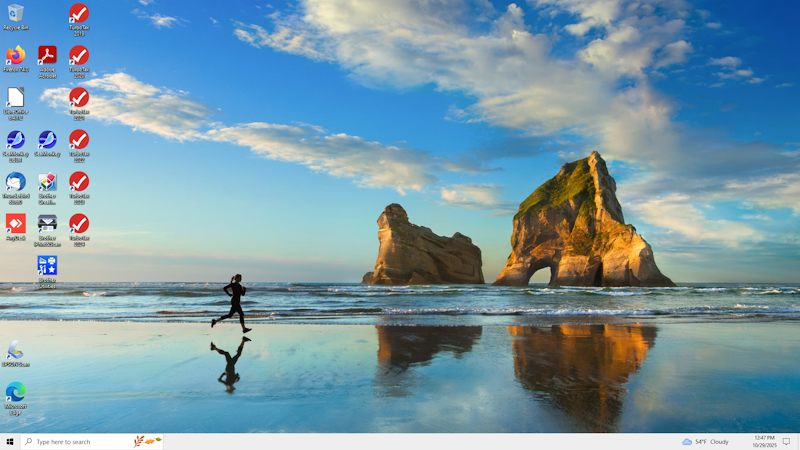My plan was to use 'Microsoft Edge' web browser to download
and install the 'SeaMonkey' web browser install package from the
SeaMonkey website.
Then I would download-and-install other apps --- Firefox, Thunderbird,
LibreOffice --- using the 'SeaMonkey' web browser.
-
To start, I wanted to review the settings in 'Microsoft Edge'
--- especially file-cleanup and privacy settings.
I logged into the HP Windows 10 PC as 'Admin' and WITHOUT
an internet connection (neither wired nor wireless).
Unfortunately not much is changeable.
I do not like the 'modern' interface of 'Microsoft Edge'
--- an interface that hides most of the options.
I like the classic interface with option like
'File', 'Edit', 'View', 'Go', 'Bookmarks', 'Tools', 'Help'
across the top 'toolbar'.
In 'Microsoft Edge', most of these kinds of options
are hidden under a '...' symbol on the right of the
'Edge' window.
I like to have a web browser remove most of the
files from a session (such as cookies) when the
web browser is closed.
In 'Edge', I checked several checkboxes to the
'Cleanup' option (Form data, passwords) ---
which already included cookies and history
checked-checkboxes.
After doing what I could to 'secure' Microsoft's
'Edge' browser, I used it to install 'SeaMonkey',
as follows.
-
SeaMonkey 2.53.1 install:
I used Microsoft Edge (version 42.17134.1.0) and the
DuckDuckGo search engine, to find and download the
SeaMonkey install file (version 2.53.1 was the latest)
from the official SeaMonkey web site --- at
'seamonkye-project.org'.
It was a 40.7 Megabyte '.exe' file.
I clicked on the install file, and after the SeaMonkey
setup 'Wizard' finished, I did some initial setup
of Bookmarks in SeaMonkey.
I used the 'Bookmarks > Manage Bookmarks...' toolbar
menu to create folders and add web-links to them.
I would need to return and use the 'Edit > Preferences'
to set various security and privacy options.
-
Firefox 74.0 install:
I used SeaMonkey and DuckDuckGo to find and download
the Firefox install file (version 74.0 was the latest)
from the officeal Firefox site --- at 'mozilla.org'.
It was a 78.9 Megabyte setup '.exe' file.
After the download (to 'ThisPC\Downloads' folder), I
right-clicked on the setup file in the SeaMonkey
'Download Manger' window and chose 'Open'.
That started the Firefox 'Setup Wizard'. I chose the
'Custom' setup option --- to have access to several
options. (I took most of the defaults.)
After the 'Setup Wizard' finished, I did some initial
setup of Bookmarks and security-privacy settings in
Firefox.
-
Thunderbird 68.6.0 install:
I used SeaMonkey and DuckDuckGo to find and download
the Thunderbird install file (68.6.0 was the latest
version) from the official Thunderbird site --- at
'thunderbird.net'.
It was a 38.7 Megabyte setup '.exe' file.
After the download --- to 'ThisPC\Downloads' folder ---
I right-clicked on the setup file in the SeaMonkey
'Download Manager' window and chose 'Open'.
That started the Thunderbird 'Setup Wizard' ---
after a prompt in a Microsoft 'User Account Control'
window:
"Do you want to allow this app to make changes to your
device?". I clicked 'Yes'.
In the 'Thunderbird Installer' window, I chose the
'Custom' setup option --- to have access to several
options.
I took most of the defaults, including the checked-checkbox
labelled 'Use Thunderbird as my default mail application'.
-
LibreOffice 6.4.1.2 install:
I used SeaMonkey and DuckDuckGo to find and download the
LibreOffice install file (6.4.1.2 was the latest version)
from the official LibreOffice site --- at 'libreoffice.org'.
It was a 298 Megabyte '.msi' setup file.
After the download (took about 2 minutes) ---
to 'ThisPC\Downloads' folder ---
I right-clicked on the setup file in the SeaMonkey
'Download Manager' window and chose 'Open'.
That started the LibreOffice 'Setup Wizard' ---
after a warning popup window about installing apps
on Microsoft Windows.
I chose the 'Custom' setup option --- to have access
to several options.
Two 'feature sets' were shown:
-
Optional Components, including 'Image Filters',
'Extensions', 'Report Builder' and 'Dictionaries'
(about 100 language dictionaries).
-
User Interface Languages (about 100 languages;
3 English were pre-selected: South Africa,
United Kingdom, United States)
Pre-selected dictionaries were: English (24MB),
French (7 MB), Spanish (7 MB)
I added: Arabic (7 MB), Italian (7 MB), Portuguese (7 MB),
Russian (7 MB), Slovak (7 MB)
After choosing to use LibreOffice to open about 5 types
of Microsoft Office documents (including Word), when I
clicked on the 'Install' button, it said it would take
several minutes to install.
Surprisingly, the progress bar was showing for no more than
60 seconds, and the install was done.
Now that I had these '3rd-party' apps installed, I wanted to
proceed to install TurboTax 2019 in order to do federal and
state taxes.
When I would do the 'Data-Migration' of Thunderbird mail files
and SeaMonkey bookmarks (in June 2021), the use of Thunderbird
would begin 'in earnest'. That 'Data-Migration' is to be
described on a separate web page.
Proceed to the next section, to see the 'userid preparation'
for the installation of TurboTax.
